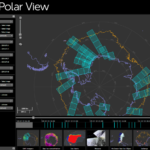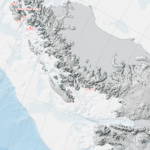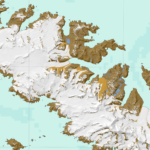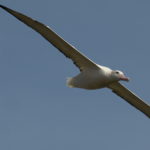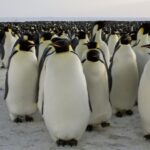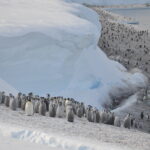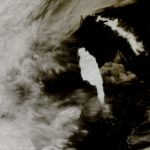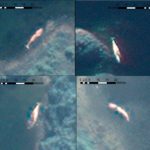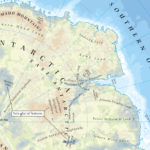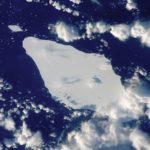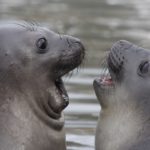Mapping and GIS team
The Mapping and Geographic Information Centre (MAGIC) provides geospatial information, expertise and services to BAS and wider UK activity in the polar regions.
Our activities include:
- Topographic mapping and Cartography
- Survey and geomatics: Aerial photography, Unmanned Aerial Systems (UAS), 3D modelling and GNSS
- Remote Sensing, Earth Observation (EO) data access and processing platforms
- Online GIS and geospatial web services
- Operational sea ice information
- Geospatial science projects
- Training
We post regular updates on Bluesky. Follow us here for further information about what we’re up to!
Antarctic Digital Database
The SCAR ADD is a seamless compilation of topographic data for Antarctica to 60°S. It is the place to go to get data such as Antarctic coastline or contours for working in desktop GIS.South Georgia GIS
Visualise and download topographic, management and scientific data for South Georgia.Bedmap3
Bedmap3 is a collaborative community project with the aim to produce a new map and datasets of Antarctic ice thickness and bed topography for the international glaciology and geophysical community, …Wildlife from Space
Many populations of wildlife are remote, inaccessible or difficult to monitor. The advent of sub-metre, Very-High-Resolution (VHR) satellite imagery may enable us study these animals in a much more efficient …Albatrosses from Space
Great (Diomedea) albatrosses face multiple threats to their long-term survival. Declines in albatross populations have been linked to incidental mortality (bycatch) in fisheries, predatory invasive species (including rats, mice and …Higher Predators – Long-Term Science
The British Antarctic Survey carries out Long Term Science that measures changes in Antarctic ecosystems and seeks to understand the underlying drivers and processes. Marine predators are sensitive to changes …Assets Tracking Service
Location tracking for BAS assets, including ships, aircraft, and vehicles.Embedded Maps Service
Embeddable maps for visualising simple features on a suitable basemap.Polar Thematic Exploitation Platform
A Polar Thematic Exploitation Platform (Polar TEP) is being developed for the European Space Agency (ESA). Polar TEP will provide polar researchers with access to computing resources, earth observation (EO) …ESA IAP ArcticSat project
Situational awareness in the ArcticEC Copernicus Marine Environment Monitoring Service
The Copernicus marine environment monitoring service provides regular and systematic reference information on the state of the physical oceans and regional seas. The observations and forecasts produced by the service …Bedmap
Bedmap is a collaborative community project with the aim to produce a new map and datasets of Antarctic ice thickness and bed topography for the international glaciology and geophysical community, …Bedmap2
understanding whats beneath the ice, opens new opportunities for detailed modelling of the past and future evolution of the Antarctic ice sheetsAutomated lithological mapping using airborne hyperspectral remote sensing
Antarctica is a unique and geographically remote environment. Field campaigns in the region encounter numerous challenges including the harsh polar climate, steep topography, and high infrastructure costs. Additionally, field campaigns …New map of South Orkney Islands published for the first time in 40 years
13 February, 2025
A new map of the South Orkney Islands has been released by British Antarctic Survey (BAS) – the first UK published, topographic map of the region in almost 40 years. …
Drones and images from space count elephant seals
12 November, 2024
A team of researchers are using drones and satellite images from space to count southern elephant seals on the sub-Antarctic Island of South Georgia. Using remotely piloted aerial systems (RPAS) …
Satellite observations show accelerating greening of Antarctic Peninsula
4 October, 2024
New research released today in Nature Geoscience reveals that vegetation cover on the Antarctic Peninsula has increased more than tenfold in the past four decades. Researchers from University of Exeter, University …
First Antarctic-wide survey of plant life to aid conservation efforts
6 August, 2024
The first continent-wide mapping study of plant life across Antarctica reveals growth in previously uncharted areas, and is set to inform conservation measures across the region. Published today in Nature …
Drones validate walrus counts in satellite images from space
22 May, 2024
In the first successful attempt to calibrate walrus counts from satellite imagery, scientists used drones to validate animal counts in Svalbard, Norway. This International Day for Biological Diversity, the researchers …
New interactive map of Antarctica available to all
18 May, 2024
Comprehensive digital maps of Antarctica are now available to all, following the latest update of the Antarctic Digital Database. A new map viewer brings together all of the Antarctic Digital …
‘Penguin detectives’ required for new counting app
2 May, 2024
This week (Thursday 2 May), British Antarctic Survey (BAS) is inviting the public to become ‘penguin detectives’ and spend five minutes counting emperor penguins to help with vital research into …
Emperor penguin colonies in Antarctica suffer as sea-ice diminishes
25 April, 2024
Record low levels of Antarctic sea-ice in late 2023 resulted in breeding failures in a fifth of the continent’s emperor penguin colonies, according to a new study from British Antarctic …
Four new emperor penguin colonies found by satellite
24 January, 2024
Scientists from British Antarctic Survey have discovered four previously unknown emperor penguin breeding sites. Changing sea ice conditions along Antarctica’s coastline have forced several emperor colonies to move in search …
New animation shows track of giant A23a iceberg
16 January, 2024
Scientists at British Antarctic Survey are using satellite images to track the colossal iceberg A23a. This new animation shows the recent trajectory of the A23a iceberg as it moves north …
Using AI to track icebergs
23 November, 2023
Researchers are using a new AI tool to detect icebergs in the Southern Ocean. This is the first step towards scientists being able to track the complete life cycle of …
Loss of sea ice causes catastrophic breeding failure for emperor penguins
24 August, 2023
Emperor penguin colonies experienced unprecedented breeding failure in a region of Antarctica where there was total sea ice loss in 2022. The discovery supports predictions that over 90% of emperor …
New map reflects ice loss and name changes
8 June, 2023
Dramatic changes in the Polar Regions are reflected in a new edition map of Antarctica and the Arctic produced by cartographers at the British Antarctic Survey (BAS). The flagship printed …
‘Walrus detectives’ sought for conservation science
16 January, 2023
This week (17 January) British Antarctic Survey and WWF are inviting the public to become ‘walrus detectives’ and get involved in the Walrus from Space project to help with vital …
Calling for ‘Walrus Detectives’ on World Walrus Day
24 November, 2022
Today, 24 November 2022, marks World Walrus Day, and British Antarctic Survey (BAS) and WWF are inviting the British public to become ‘walrus detectives’ and get involved in their Walrus …
Drones survey wildlife populations in remote Sub-Antarctic island
17 November, 2022
Next generation fixed-wing drones, capable of operating autonomously beyond the standard visual line of sight, are creating datasets of major wildlife populations around South Georgia for long-term monitoring to aid …
Albatrosses from space: wildlife detectives needed!
4 September, 2022
British Antarctic Survey (BAS) and RSPB are recruiting albatross detectives to help to search for wandering albatrosses in satellite images taken from space. This is to help us learn more …
BAS mapping data in global collection
19 May, 2022
The latest British Antarctic Survey (BAS) Antarctic Digital Database (ADD) data will be included in a world leading collection of geographic information.
‘Mega iceberg’ releases billions of tonnes of fresh water into ocean
20 January, 2022
Scientists monitoring the giant A68a iceberg from space reveal that a huge amount of fresh water was released as it melted around the sub-Antarctic island of South Georgia. An …
Space technology and artificial intelligence to monitor whale mass stranding events
18 November, 2021
An international team of scientists led by British Antarctic Survey have published research today on using new technology to study mass stranding of whales from space and how the technology …
WALRUS FROM SPACE: Animal spotters wanted to join mass survey!
14 October, 2021
British Antarctic Survey (BAS) and WWF are seeking the public’s help to search for walrus in thousands of satellite images taken from space, with the aim of learning more about …
Climate change risk to emperor penguins
3 August, 2021
British Antarctic Survey scientists have contributed to a new study published today (3 August) which provides valuable new data highlighting how emperor penguins extinction risk is increased due to rapid …
Using AI to track whales from space
4 February, 2021
British Antarctic Survey (BAS) scientists will work with an Artificial Intelligence company after being awarded a contract from the Canadian Space Agency (CSA) to support the protection of an endangered …
Giant iceberg mission begins
2 February, 2021
A research mission to determine the impact of the giant A-68a iceberg on one of the world’s most important ecosystems departs from Stanley in the Falkland Islands today (2 February …
Polar scientists and staff awarded place names in Antarctica
3 December, 2020
The Government of the British Antarctic Territory today (Thursday 3 December) announces 28 new place names in the Territory
A68 iceberg heads towards South Georgia
4 November, 2020
An iceberg is heading towards the sub-Antarctic island of South Georgia. A68a – the size of the UK county of Somerset – broke off from the Larsen C ice shelf …
Scientists discover new penguin colonies from space
5 August, 2020
A new study using satellite mapping technology reveals there are nearly 20% more emperor penguin colonies in Antarctica than was previously thought. The results provide an important benchmark for monitoring …
Updated Mapping Datasets for Antarctica
12 May, 2020
A newly updated Antarctic Digital Database is released today (12 May 2020). Aimed at the science and logistics communities, the maps include updates to the ice shelf front around Thwaites …
New high-precision map of Antarctica’s bed topography
12 December, 2019
A team of glaciologists has unveiled the most accurate portrait yet of the contours of the land beneath Antarctica’s ice sheet – and, by doing so, has helped identify which …
Stranded whales detected from space
17 October, 2019
A new technique for analysing satellite images may help scientists detect and count stranded whales from space. Researchers tested a new detection method using Very High Resolution (VHR) satellite images …
New map of Greenland reveals fast-changing environment
13 June, 2019
Cartographers at British Antarctic Survey (BAS) has produced the most detailed and up-to-date published map of Greenland available.
“Catastrophic” breeding failure at one of world’s largest emperor penguin colonies
25 April, 2019
Researchers at British Antarctic Survey have discovered “catastrophic” breeding failure at one of world’s largest emperor penguin colonies.
Watching whales from space
1 November, 2018
Scientists have used detailed high-resolution satellite images provided by Maxar Technologies’ DigitalGlobe, to detect, count and describe four different species of whales. Reported this week in the journal Marine Mammal …
New map of South Georgia wins award
7 September, 2018
British Antarctic Survey’s detailed map of the sub-Antarctic island of South Georgia featuring the epic “Shackleton Crossing” has won an award at the 2018 British Cartography Society Awards. The map, …
New satellite imagery reveals new highest Antarctic Peninsula Mountain
11 December, 2017
Cartographers surveying Antarctica have discovered Mt Hope is the tallest mountain in the British Antarctic Territory (BAT) at 3,239 m (10,654 ft) above sea level. Until now, maps showed Mt …
New map of South Georgia unveiled
24 August, 2017
A team of cartographers at British Antarctic Survey (BAS) has re-produced a high-resolution updated map of the sub-antarctic island of South Georgia. The island, situated at 37°W 54°10’S is a …
Penguin colony repeatedly decimated by volcanic eruptions
11 April, 2017
One of Antarctica’s biggest gentoo penguin colonies was repeatedly decimated by eruptions of the Deception Island volcano in recent millennia.
Giant iceberg set to calve from Larsen C Ice Shelf
6 January, 2017
A huge iceberg, roughly the size of Norfolk, looks set to break away from the Larsen C ice shelf on the Antarctic Peninsula. Larsen C is more than twice the size …
Penguin colonies at risk from erupting volcano
6 July, 2016
A volcano erupting on a small island in the Sub Antarctic is depositing ash over one of the world’s largest penguin colonies.
On the ice opportunity for PhD students and Early Career Researchers
7 April, 2016
16 PhD students and Early Career Researchers have a unique opportunity to gain practical skills for working safely and effectively in the polar regions.
NEWS STORY: New maps show unseen world
25 September, 2014
New maps of the polar regions reveal unseen world beneath the ice and highlight dramatic decline in Arctic sea ice cover New maps of the sub-ice features in Antarctica and …
NEWS STORY: Emperor Penguins’ adaptation skills
24 June, 2014
New research using satellite images reveals that emperor penguins are more willing to relocate than previously thought A new study led by the University of Minnesota offers new insights on …
NEWS STORY: Award for innovative map
3 October, 2013
Map makers rewarded for stunning recreation of Antarctic without ice A colourful British Antarctic Survey map has won a coveted award. The map, created by the institution’s MAGIC (Mapping and …
NEWS STORY: Bedmap opens up Antarctica
8 March, 2013
Bedmap2 gives scientists a more detailed view of Antarctica”s landmass Scientists at the British Antarctic Survey have been working with a host of international collaborators to present the most detailed …
NEWS STORY: Queen Elizabeth land
18 December, 2012
UK names part of Antarctica in honour of the Queen The Foreign Secretary, William Hague, has announced that the southern part of British Antarctic Territory has been named Queen Elizabeth …
International ice experts caution that ‘Open’ Arctic shipping routes does not mean ice-free waters
21 October, 2011
Ice experts from agencies from nine countries this week issued a statement urging marine and shipping companies operating in the region of the Northwest Passage and the Northern Sea Route …
Polar View in the Antarctic
8 February, 2010
As the Antarctic field season continues with the usual mix of exciting research programmes new enhancements to the online satellite image system that improves ship safety and efficiency are launched. …
PRESS RELEASE: Interactive map highlights diversity
22 October, 2008
New visualisation of South Georgia A new visualisation tool for exploring the subantarctic islands of South Georgia is unveiled today (22 October 2008). The South Georgia Geographic Information System (SGGIS) …
Giant iceberg breaks off from Antarctic glacier
16 October, 2007
Giant iceberg breaks off from Antarctic glacier British Antarctic Survey (BAS) scientists have spotted a huge iceberg, which has broken off from Pine Island Glacier in West Antarctica. The iceberg, …
Antarctic Digital Database – December 2024 update
19 December, 2024 by Laura Gerrish
Continuous mapping of Antarctica reveals new topographic features In November, we released version 7.10 of the SCAR ADD which included updated coastlines for the Alexander Island region, and new lakes, …
How many penguins are in Antarctica?
25 April, 2023 by Michael Dunn
No, it’s not a Penguin joke! This World Penguin Day (25 April 2023) we spoke to some of our resident experts, Mike Dunn and Peter Fretwell, to find out more …
Last Post from the burning decks of a melting iceberg
22 March, 2023 by Emily Newton
Composer Ewan Campbell has written a piece of music for trumpet inspired by the 21-year journey of the A22a iceberg. The new composition was also illustrated onto a British Antarctic …
Antarctic Digital Database – May 2021 update
18 May, 2021 by Laura Gerrish
Welcome to the new Antarctic Digital Database (ADD) blog series, updating our users about each update of the datasets in the ADD and about other pieces of work happening in …
PODCAST – Iceworld, Episode 5 – Seals from Space
9 April, 2020 by Robert Taylor
Episode 5: Seals from Space In Episode 5 of Iceworld, Rob Taylor is joined by Prem Gill who has just completed two weeks of fieldwork as part of his PhD …
PODCAST – Iceworld, Episode 1 – Maps
1 November, 2019 by Robert Taylor
Mapping in Antarctica – podcast
Feasibility of using very high-resolution satellite imagery to monitor Tristan albatrosses Diomedea dabbenena on Gough Island
4 April, 2025 by Ellen Bowler, Marie Attard, Peter Fretwell, Richard Phillips
The Tristan albatross Diomedea dabbenena is a Critically Endangered species that breeds exclusively on remote islands in the South Atlantic Ocean. Although the population continues to decline, regular on-the-ground monitoring…Surface darkening by abundant and diverse algae on an Antarctic ice cap
18 March, 2025 by Hannah Moulton, Lloyd Peck, Peter Convey, Peter Fretwell
Algal blooms play important roles in physical and biological processes on glacial surfaces. Despite this, their occurrence and impacts within an Antarctic context remain understudied. Here, we present evidence of…Read more on Surface darkening by abundant and diverse algae on an Antarctic ice cap
Bedmap3 updated ice bed, surface and thickness gridded datasets for Antarctica
10 March, 2025 by Alice Fremand, Andy Smith, David Vaughan, Ed King, Elena Field, Fausto Ferraccioli, Hugh Corr, Hamish Pritchard, James Kirkham, Peter Fretwell, Richard Hindmarsh, Tom Jordan, Richard Hindmarsh
We present Bedmap3, the latest suite of gridded products describing surface elevation, ice-thickness and the seafloor and subglacial bed elevation of the Antarctic south of 60 °S. Bedmap3 incorporates and…Read more on Bedmap3 updated ice bed, surface and thickness gridded datasets for Antarctica
A circumpolar review of the breeding distribution and habitat use of the snow petrel (Pagodroma nivea), the world’s most southerly breeding vertebrate
1 March, 2025 by Dominic Hodgson, Peter Fretwell, Richard Phillips
Knowledge of the spatial distribution of many polar seabird species is incomplete due to the remoteness of their breeding locations. Here, we compiled a new database of published and unpublished…A polar oceans shipping information system
1 February, 2025 by Andrew Fleming, Alexander Tate, Andreas Cziferszky, Jeremy Wilkinson, Michael Thorne
Globally, ships above a certain tonnage, as well as an increasing number of smaller vessels, rely on the AIS (Automatic Identification System) to safely navigate around other vessels, which are…A comparison of established and digital surface model (DSM)-based methods to determine population estimates and densities for king penguin colonies, using fixed-wing drone and satellite imagery
29 November, 2024 by Adrian Fox, Ashley Bennison, Jamie Coleman, Louise Ireland, Martin Collins, Nathan Fenney, Philip Hollyman, Philip Trathan
Drones are being increasingly used to monitor wildlife populations; their large spatial coverage and minimal disturbance make them ideal for use in remote environments where access and time are limited.…Walruses from space: walrus counts in simultaneous remotely piloted aircraft system versus very high-resolution satellite imagery
30 October, 2024 by Hannah Cubaynes, Jaume Forcada, Peter Fretwell
Regular counts of walruses (Odobenus rosmarus) across their pan-Arctic range are necessary to determine accurate population trends and in turn understand how current rapid changes in their habitat, such as…Sustained greening of the Antarctic Peninsula observed from satellites
4 October, 2024 by Andrew Fleming, Dominic Hodgson, Peter Fretwell
The Antarctic Peninsula has experienced considerable anthropogenic warming in recent decades. While cryospheric responses are well defined, the responses of moss-dominated terrestrial ecosystems have not been quantified. Analysis of Landsat…Read more on Sustained greening of the Antarctic Peninsula observed from satellites
A satellite-derived baseline of photosynthetic life across Antarctica
6 August, 2024 by Joanne Johnson, Peter Convey, Peter Fretwell
Terrestrial vegetation communities across Antarctica are characteristically sparse, presenting a challenge for mapping their occurrence using remote sensing at the continent scale. At present there is no continent-wide baseline record…Read more on A satellite-derived baseline of photosynthetic life across Antarctica
Four unreported emperor penguin colonies discovered by satellite
1 August, 2024 by Peter Fretwell
Predictions of the future emperor penguins population, linked to anthropogenic climate change, are stark. Current models suggest that if CO2 emissions continue to rise at present rates, almost all colonies…Read more on Four unreported emperor penguin colonies discovered by satellite
Sea ice detection using concurrent multispectral and synthetic aperture radar imagery
1 May, 2024 by Andrew Fleming, Scott Hosking, Jeremy Wilkinson, Maria Fox, Martin Rogers
Synthetic Aperture Radar (SAR) imagery is the primary data type used for sea ice mapping due to its spatiotemporal coverage and the ability to detect sea ice independent of cloud…Read more on Sea ice detection using concurrent multispectral and synthetic aperture radar imagery
Using telemetry data and the sea ice satellite record to identify vulnerabilities in critical moult habitat for emperor penguins in West Antarctica
1 May, 2024 by Andrew Fleming, Louise Ireland, Philip Trathan
We tracked adult emperor penguins from Rothschild Island, west Antarctic Peninsula in 2015/2016 during a summer with extensive sea ice of long duration, contrasting with past years of reduced sea…Advances in remote sensing of emperor penguins: first multi-year time series documenting trends in the global population
13 March, 2024 by Philip Trathan, Peter Fretwell
Like many polar animals, emperor penguin populations are challenging to monitor because of the species' life history and remoteness. Consequently, it has been difficult to establish its global status, a…Review of Satellite Remote Sensing and Unoccupied Aircraft Systems for Counting Wildlife on Land
8 February, 2024 by Ellen Bowler, Hannah Cubaynes, Marie Attard, Penny Clarke, Peter Fretwell, Richard Phillips
Although many medium-to-large terrestrial vertebrates are still counted by ground or aerial surveys, remote-sensing technologies and image analysis have developed rapidly in recent decades, offering improved accuracy and repeatability, lower…Overview of the Lost Meteorites of Antarctica field campaigns
1 February, 2024 by Laura Gerrish, Michael Rose
The Lost Meteorites of Antarctica project was the first UK-led Antarctic meteorite recovery expedition. The project has successfully confirmed two new high-density meteorite stranding zones in the Hutchison Icefield and…Read more on Overview of the Lost Meteorites of Antarctica field campaigns
A 6 year assessment of low sea-ice impacts on emperor penguins [Short Note]
1 February, 2024 by Peter Fretwell
Sea ice, and particularly land-fast sea ice, is crucial for emperor penguins as a breeding and moulting platform and foraging habitat (Barbraud & Weimerskirch 2001). Emperor penguins use land-fast sea…Read more on A 6 year assessment of low sea-ice impacts on emperor penguins [Short Note]
Loss of research and operational equipment in Antarctica: Balancing scientific advances with environmental impact
15 December, 2023 by Claire Boyle, Kevin Hughes, Laura Gerrish, Peter Convey, Steve Colwell
Antarctica has been subject to widespread, long-term and on-going human activity since the establishment of permanent research stations became common in the 1950s. Equipment may become intentionally or inadvertently lost…Gray whale detection in satellite imagery using deep learning
1 December, 2023 by Hannah Cubaynes, Jennifer Jackson, Katherine Green, Peter Fretwell
The combination of very high resolution (VHR) satellite remote sensing imagery and deep learning via convolutional neural networks provides opportunities to improve global whale population surveys through increasing efficiency and…Read more on Gray whale detection in satellite imagery using deep learning
Unsupervised machine learning detection of iceberg populations within sea ice from dual-polarisation SAR imagery
1 November, 2023 by Andrew Fleming, Anita Faul, Ben Evans, David Vaughan, Scott Hosking
Accurate quantification of iceberg populations is essential to inform estimates of Southern Ocean freshwater and heat balances as well as shipping hazards. The automated operational monitoring of icebergs remains challenging,…How precisely can we map blue ice in Antarctica?
19 October, 2023 by Peter Convey, Peter Fretwell
Precise mapping of Blue Ice Regions (BIRs) in Antarctica can facilitate resource management during expeditions and help plan field investigations. Satellite-based BIR mapping was traditionally performed with large-swath, coarse to…Read more on How precisely can we map blue ice in Antarctica?
